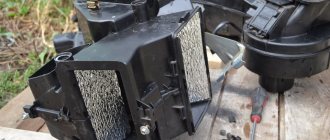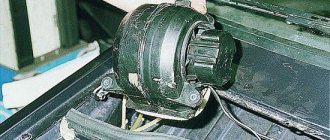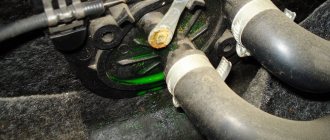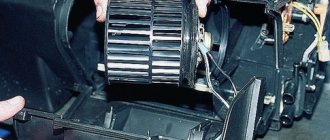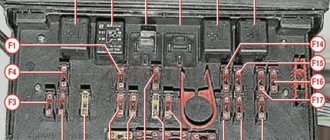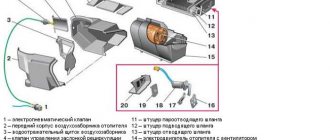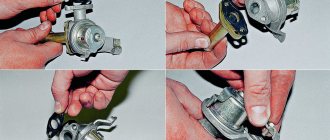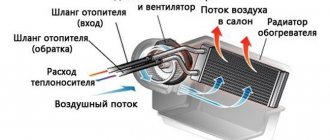VAZ cars are very popular among drivers due to their decent technical characteristics, price-quality ratio, and excellent maintainability. Most malfunctions that occur during operation can be corrected by the driver independently without the help of professionals.
In this article we will talk about repairing a vehicle heater, which is one of the weak points in domestically produced cars, namely, we will look at how to replace a failed VAZ-2110 heater resistor.
Do-it-yourself replacement of a VAZ-2110 heater resistor
In order to replace the resistor, it is important to understand where exactly it is located.
The part is located on the right side of the stove behind the vacuum booster. First of all, before starting work, you need to disconnect the battery from the power supply; to do this, remove the negative wire from the terminal.
Further work is carried out inside the car. Initially, it is necessary to dismantle the windshield trim and trim. After this, the soundproofing padding on the right side of the machine panel is removed. To gain good access to the converter, the vacuum booster must be removed.
An additional heater resistor came into view. Next, you should disconnect the block with wiring from the contacts of the converter. Remember exactly how it is connected so that you can reassemble it correctly when you are finished. The block can only be connected in one position.
Before you start replacing the product, you need to check its operation using an ohmmeter. There is no need to remove it to check the functionality of the part. Connect the contacts of the converter and ohmmeter in series, first on the first spiral, then on the second. If the resistance values differ significantly from the optimal value for the correct operation of the device, then the product must be replaced.
Often the cause of part failure is the disconnection of the fuse located on the resistor board. Theoretically, you can extend the life of the element by soldering the fuse contacts in place. However, such work is characterized by significant difficulties, since it is very inconvenient to get to the fastening of the fuse contacts due to the very small distance between the board and the converter itself.
The price of a high-quality resistor is not very high, so the correct solution would be to replace it with a new part. Before replacing, purchase a new product from a specialized store. Do not buy parts secondhand or in spontaneous markets. Only a high-quality product can guarantee uninterrupted operation of the heating system of the car interior. The VAZ-2110 is equipped with a product with identification value RDO 2110-8118022-01. Buy products that match your car make, this will ensure correct current conversion and correct operation of the interior heating system.
To dismantle the product, you need to unscrew the fastening screw using a Phillips screwdriver. The failed part is carefully removed and a new converter is installed in its place. At this point the replacement can be considered completed. All that remains is to connect the block and connectors in place, and install the windshield trim in the reverse order.
Functions and purpose of the resistor
A resistor is often used in many vehicle electrical circuits. Its main function is the control and distribution of the supplied current to the element of its consumption, in this case to the car’s stove.
In cars, the source of current is the battery, which generates the necessary electrical charge for the functioning of all electrical elements of the vehicle. The resistor, in turn, transforms the current into the required voltage limits for the uninterrupted operation of a particular part. If the current converter becomes unusable, then more voltage will be supplied to the stove than is required for its operation, and the interior heating system will not work. Also, high voltage can cause burnout of heater parts that operate on current.
The functionality of the part is simple. Initially, the current is generated in the car battery and supplied to the heater resistor. It transforms it into the required voltage value for high-quality operation of the heater.
The reasons for the failure of the converter may be heavy loads on it in case of long-term operation of the stove at maximum speed, or faulty wiring. As well as the quality of the resistor and suitability for the destination, it affects its service life.
Features of the system design
The heater and the entire heating system of the VAZ-2114 are in many ways similar to its predecessors. It is considered simple, which makes DIY repair possible.
Installation and repair of VAZ cars (2110 and Lada Priora)
Main components of the heating system:
- fan;
- stove tap (faucet or switch);
- radiator;
- air flow regulator.
The design is simple. Air is supplied inside the cabin through dampers. The resistor is responsible for the fan power and its operation. If the resistor on the VAZ-2114 stove fails, the regulator in the first and second positions stops working.
Important! If you do not change the element of the heating system and leave everything as is, then warming up the interior will take a very long time. In cold winter conditions, you will not have enough patience and health
In the VAZ-2114 heating system there are two spirals, the resistance of which is 0.23 and 0.82 Ohms. When the fan is in the first position, current is supplied through two spirals. Switching to the second position allows electricity to flow through one coil, so there is less resistance.
And when the regulator is in the 3rd position, the fan receives current from the motor, that is, bypassing the resistor. So if the stove does not work in the first two positions, then the reason is in this element of the VAZ-2114 heating system.
Nuances and location
To replace a device, you need to know where it is and why it needs to be replaced rather than repaired.
VAZ heater blower speed 1 2 does not work (repair)
- The designers of the VAZ-2114 did not hide the resistor very far. It is located above the gas pedal. That is, you need to look for the element on the driver’s side. To access the device, you do not need to unscrew or remove anything.
- Its breakdowns are rare. Usually problems appear due to melted tip pads or burnt contacts. To fix the heating, you need to clean the contacts, buy and install a block.
- Experienced VAZ-2114 owners advise always having a new resistor in reserve. It will help you quickly, by elimination, determine the cause of the heating system problem. Not everyone can visually determine whether a resistor has burned out or not. By inserting a new one in place of the old one and checking the operation of the heater, you will see whether it is to blame or whether the problem needs to be looked for in other places.
- Principle of operation. The resistor is used to regulate the speed of the stove. It is needed to create resistance in order to reduce voltage. For the VAZ-2114 there is an element with two resistance spirals. The resistance of the first spiral is 0.23 Ohm, and the resistance of the second spiral is 0.82 Ohm. This allows you to turn on the stove in two operating modes through one resistor.
Why the stove does not work in a VAZ 2110 family car
The heating system of the VAZ 2110 has several varieties. The older version was produced until 2001 and had on board the then current controller 1303.3854, which was later replaced by the newer 1323.3854. The changes also affected the material of the dampers, which rather made life more difficult for drivers than brought anything useful.
Despite all the inconveniences, this version of the VAZ is very popular among a large number of drivers due to the low cost of parts and its adaptability to domestic roads. You can either repair the heating system yourself or take it to a service center, where it will be quickly repaired by professionals.
If your VAZ 2110 stove does not work, then this may be due to several factors:
- perhaps you have an antifreeze leak;
- the ACS controller is faulty;
- the temperature sensor is broken;
- the dampers refused to work;
- The temperature has ceased to be regulated.
Heating is one of the most problematic components of this car. It constantly goes into a state of malfunction and creates problems for both the driver and passengers in the cabin. In this article you will learn why the stove stopped working and how to quickly determine it.
Trouble-shooting
Checking the cabin air temperature sensor
You can check the serviceability yourself; special skills are not required. Carefully remove the sensor from its original place. We find the contacts on the back side. Using a multimeter, apply a voltage of 1.2V. We set the regulators of the automatic heater control system to the “Min”, “Max” positions. The motor should not be activated.
The second method is to turn off the cabin air sensor. Check fan speed settings. The first speed (“A”) should be inactive.
Heater VAZ 2110: faults, repair and replacement step by step instructions
Video: Heater VAZ 2110, 11, 12. Design and principle of operation.
Heater VAZ 2110; eleven; 12. Design and principle of operation.
Checking the proper operation of the automatic control system
The proper operation is checked with a multimeter. The voltage at the terminals of the pink and brown wires is measured, the ignition is activated. Smoothly turn the temperature regulator; the arrow on the multimeter display should show an increase in voltage.
On old-style heaters, at maximum voltage, the controller value remains unchanged. Take this into account so as not to make hasty conclusions about the malfunction of a particular unit.
The cause of controller malfunction may also be deformed dampers. To verify this and eliminate the breakdown, we disassemble the heater.
Prevention of the damper of the heating system of VAZ 2112
To be precise, two dampers are subject to inspection; this is the number of them present in the VAZ 2112. The cold air intake is regulated in the upper part. In the lower part, warm (hot) air is supplied to the car interior. Due to wear on the drive mechanism, the damper opens halfway or partially, the air flow is reduced, and the interior is not heated sufficiently.
Reasons for failure:
- biting, jamming during operation, due to the lack of a sufficient amount of lubricant;
- a lot of debris, moisture, sand, dirt, which contributed to jamming;
- failure of the gear motor damper cable;
- numerous layers, rust, corrosion.
The old and new dampers differ only in the type of sealing ring. In the old ones it is plastic with foam rubber, in the new ones it is a metal seal with rubber. If you can’t hear the movement of the “curtain”, move it, set it in motion, after first removing the deflectors from the central part of the dashboard with a flat-tip screwdriver. Be careful, as the plastic casing of the console is damaged.
Metal ones are better and more practical, but they are afraid of moisture, rust, and deposits. Plastic ones, on the contrary, are deformed from heat and elevated temperatures.
The second way to check the performance of the damper: if the windshield heats hot air, but the sides or legs are warm, there is a malfunction. There is no air flow - the microdetector has failed. This is the drive mechanism.
Defective damper micro-reducer
Diagnostics is permissible if you have a special device - an ohmmeter. It is designed to measure resistance in an electrical circuit. In old-style controllers, the indicators are in the range of 750 - 1250 Ohms, in new ones - 3400 - 5100 Ohms.
Troubleshooting occurs as follows: we start the power unit, set the temperature to o, wait 15 - 20 seconds, turn it off. We disconnect the controllers, measure the resistance with the ignition on between contacts X1.4 and X1.1.
Control unit for the VAZ 2110 stove. main malfunctions of the VAZ 2110 stove and their elimination
At maximum temperature, the ohmmeter shows up to 5.0 Ohms on the new one or 1.6 Ohms on the old one. The absence of resistance indicates a malfunction: failure of the micro-gear sensor. More often, the tracks wear out, the wiring becomes damaged, and the fuse blows. To replace the micro-reducer, the stove is disassembled.
Fan runs at one speed
If the motor rotates only in the first two speed modes, then look for the reason in the resistor. It's faulty. Activation only at the third speed indicates “direct” operation, bypassing resistors. The reason is worn tracks on the switch, temperature controller.
Diagnosis of resistance resistor
The resistor design contains two spirals: the first with a resistance of 0.23 Ohms, the second with 0.82 Ohms. When both spirals are activated, the fan operates at the first speed; when one is activated, the motor operates at the second speed. When starting directly without a resistor, third gear is activated.
The most common causes of breakdowns of the VAZ 2112 stove are low levels of antifreeze, air in the system, malfunctions of the thermostat and pump.
Speed control
In order to be able to control the speed, there is an additional resistor located behind the vacuum booster, on the side of the heater. It is equipped with 2 spirals: the 1st has a resistance of 0.23 Ohm and provides the lowest, 1st fan rotation speed. The 2nd, at 0.82 Ohm, makes it possible to turn on the 2nd speed. If this part is working properly, the driver has the ability to control the temperature in the cabin, lowering it or raising it. If it fails, then there is only one speed left for the heater - the highest. It is the additional VAZ resistor that ensures their switching, not counting the last one. Therefore, in fact, the highest one works if it breaks.
The stove fan does not work in positions 1,2,3 | VAZ-2110 11, 12, 13 Priora, Repair for pennies
heater fan did not work
at positions 1,2,3, the prerequisite is overheating of the thermoelement on the rheostat.
The resistor of the electric heater motor on a VAZ 2110 car is responsible for the operation of the engine in various modes (minimum speed, average and maximum). The resistor can be removed for replacement if it fails. To carry out repair work, prepare a standard set of tools and perform the following sequence of actions:
- De-energize the vehicle by disconnecting the negative terminal from the battery.
- Remove the decorative trim and trim from the windshield window.
- Remove the right soundproofing pad.
PWM backlight controller. — Lada 2114, 1.5 l., 2004 on DRIVE2
Then he began to redesign the insert.
I cut a hole measuring 22x40mm and several additional holes.
That's how it happened
Then I decided to glue the beads to make it look more factory-like.
Next, I sanded the insert and applied putty where necessary.
After all the manipulations, I painted the insert. In a good way, it still needs to be coated with matte varnish, but the store didn’t have it, they promise to bring it this week, so as soon as it arrives, I’ll cover it.
I also decided to overexpose the regulator itself. I opened it and soldered it to other 3mm LEDs.
All that was left to do was cut a hole in the panel. First I went through it with a soldering iron, and then leveled it with files.
I pulled out the factory rheostat and removed the block from it in order to connect the new regulator according to the standard one.
I inserted the block into the standard harness and screwed on the ground for the regulator. And now, as for connecting the regulator itself: 58 – “+ input”, 58b – “+ going to the backlight”, 31 – “ground”.
Well, the end result.
UPD. Covered with matte varnish.
Full size
Added a video of the work.
Everything is perfectly regulated, which makes me incredibly happy! Thank you all for your attention and good luck on the road!)
Purpose and design of the gearmotor
The VAZ 2110 heater gear motor (or servo drive) is used for automated control of the interior heater damper. The heater damper regulates the temperature of the air supplied to the vehicle interior. This innovation from AvtoVAZ replaced the outdated cable system used to control the heater damper in classic models.
The VAZ-2110 gear motor is available in two versions: new and old. The old-style motor is metal, with a rod for connecting to the damper drive. The new type of gearmotor is plastic, with a shaft shank that connects directly to the damper mechanism.
The design of the gearmotor is simple. A motor, housed in a plastic or metal case, with a rated voltage of 12 volts, rotates a system of toothed plastic gears. The purpose of this system is to reduce the speed of the output shaft and increase the torque on it. The output shaft acts on the thrust or damper drive.
The heater drive is controlled by an electronic control unit, which is located on the dashboard under the heater control knobs. The motor is reversed by changing the polarity of the supplied voltage. Feedback to the control unit is provided by a position sensor.
The gear motor of the VAZ-2110 stove is located on the left side of the engine compartment under the upper plastic protection. Attached to the stove body with three screws.
Replacing the heater radiator (stove) on VAZ 2110, 2111 and 2112 VAZ 2111 - Replacing the heater radiator and damper gear motor Replacing the heater radiator VAZ 2110 (old model)
Functional purpose of an automotive resistor
VAZ 2110 heater resistor replacement
From a practical point of view, a resistor acts as a current intermediary between the source and the final destination. The source of current in a car is the battery, but the final destination is any device that requires electricity. Main functions of car resistor:
The role of the resistor in maintaining the functioning of the heater
Replacing the resistor of the VAZ 2110 stove
The heater, also known as a heating furnace, operates thanks to the incoming electrical energy. The electricity itself is generated by the battery and then sent to the furnace. In this simple circuit, the role of the resistor (see How to replace the heater resistor on a VAZ 2110) is to create the required voltage level.
Note. Objectively, it is necessary to understand that there are many resistors in a car, but there is only one battery and it produces a certain amount of voltage. Thanks to the resistor, the current is transformed into the required value limits. If the voltage is small, the device will not work. On the contrary, applying excessive voltage will lead to burnout of the device that operates on current.
Checking components
Naturally, disassembling the stove on a VAZ 2110 and checking its components is necessary if you are dissatisfied with its operation, and also if it cannot be adjusted.
The first thing to do is check to see if the fuse has blown. And although, if this happens, the thought immediately arises - change the blown fuse, do not rush. This is unlikely to immediately solve the problem; most likely, it is not the cause, but a consequence of some kind of failure that needs to be found; First of all, you need to check whether the damper moves when the parameters of the heater sensor change
Carefully, so as not to break the wire going to the backlight, remove the deflectors. Now you can clearly see whether the damper is turning or not
If you need to replace the heater damper, then installing an aluminum one instead of a plastic one will be justified; Check the resistance of the temperature sensor. If the temperature in the cabin is 16°C, then its resistance should be 250 Ohms, at 22°C - about 200 Ohms. If this is not the case, then installing a new sensor should help; It is also advisable to check the controller: remove it from the socket, turn on the ignition and, using the handle to change the temperature parameters, measure the voltage on the long connector. If the voltage does not change, then it is faulty; To check the gear motor of the stove, you will have to do a little disassembly: remove the frill, get to the drive of the gear motor (brown and pink wires are connected to it). Apply current from the battery to the connector. If it spins, it means it’s working, if not, you may need to install a new one; If the heater only operates in one position, the additional resistance (resistor) through which the fan is connected may have burned out. Installation of a new one is possible only from the engine compartment; Check if the wires in the controller are burnt out. To do this, it needs to be disassembled; On the right under the hood you will find the relay box. It is very possible that a wire has come loose from the relay responsible for operating the heater. At the same time, check the relay that turns on the heated rear window. If you do not have such heating, when tuning the stove, you can include this relay in the system; If the air entering the VAZ 2110 interior does not warm up sufficiently, be sure to check the antifreeze level, as well as the absence of its leakage from the heater;
Why does the VAZ-2110-2112 “stove” not heat up?
If you are thinking about tuning the stove, then you should know that it is possible to install not only the “native” model, but also many others: Priorovskaya, Boshevskaya, etc.
Revision of automatic control system VAZ 2110
Checking the resistance resistor
The stove resistor has 2 spirals, the resistance of the 1st is 0.23 Ohms, and the 2nd is 0.82 Ohms. When both are activated, the heater electric motor operates at the first speed, but if the resistor operates at the first spiral, then the 2nd speed is activated. At the third, maximum fan speed, when the resistor is not used. When the electric motor is turned on without a resistor, the fan rotor rotates at the maximum 3rd speed.
In addition to the above malfunctions, the stove may also not work due to a low level of antifreeze, air in the cooling system, or a non-working thermostat or pump.
As you know, a car is a semi-autonomous device that functions thanks to a combination of complex components. Today, VAZ cars in Russia are highly popular. However, sometimes unexpected malfunctions can and do occur. For example, you may need to replace the resistor on the VAZ 2110 stove. For its practical implementation, you need to know the cause of this malfunction and the ability to eliminate it. On a VAZ 2110, replacing the resistor on the stove is a responsible task, but you can handle it yourself.
SAUO repair
Before repairing the SAUO VAZ 2110 unit, you should make sure that the problems with the stove are associated with it. To do this, you should connect a known working heater control unit (borrow from a friend or from a store). If there are no problems with the stove with the working unit of the automatic control system, then we try to find out what the reason is. If the obviously working unit of the automatic control system did not help, then the problem with the stove lies elsewhere.
Remove the buttons next to the SAUO block. We take out the stove control unit. Set the controls to position 0 and remove, and then remove the front cover and glass from the latches. We unscrew 2 screws in the front and 1 in the back. Remove the board from the plastic case and check the integrity of all tracks, jumpers and resistors. In this example, a broken jumper was found. Solder it on one side and the other. Assembly in reverse order. Now all speeds of the SAUO block work.
FAQ on the operation of the VAZ 2110 stove
1st oven speed does not work
All heater fan speeds (except the last one) are connected through an additional heater resistor, which is located under the frill (wind flap). One of the reasons when the first speed of the heater does not work is a malfunction of this resistor. Depending on the ACS unit, this additional resistor varies:
RDO 2108-8101081 is used on the oldest SAUO units, which have only 2 speeds. (0 A 1 2).
RDO 2110-8118022-01 is installed on a modified heater until September 2003, the SAUO unit has 3 speeds (0 A 1 2 3). The most common malfunction in this resistance is that all stove speeds stop working, except maximum 3. The reason is that the thermal fuse is unsoldered (indicated by a red arrow), and is treated by soldering it in place. But if it is unsoldered later, you need to look in the direction of the motor, the motor takes a very large current (not lubricated, wear on the brush assembly, etc.).
RDO 2123-2118022 has been installed on the latest heaters since September 2003, the SAUO unit has 4 speeds and does not have an auto mode (0 1 2 3 4).
- In addition to a malfunction of the additional heater resistor, the problem may also be in the contacts of the heater control unit board. Often, due to high temperatures, the board becomes very hot and the contact is soldered off. Carefully examine all contacts on the boards, especially at the power supply points.
- Clean contacts.
How to replace the RDO sensor on a VAZ 2110 2002. Author Dankn. Only speed 4 worked for me, the others did not.
- Remove the insulation;
- Remove the frill;
You will need a long Phillips screwdriver.
How to replace the RDO sensor in the service manual.
Heater speed 2 doesn't work
The reason is exactly the same as in the case when the first heater speed does not work.
3rd speed heater doesn't work
- If the 3rd speed is the last, then it works without resistance (directly). And the problem may be in the contacts of the ACS unit (stripped/crimped), or in the contacts on the board of the ACS unit.
- If you have a stove control unit with 4 fan speeds (0 1 2 3 4), then look for problems with the 1st stove speed.
4th oven speed does not work
The reason is exactly the same as in the case when the third heater speed does not work.
The stove blows equally at speeds 1 and 2, that is, there is almost no difference between the first speeds, but at speed 3 it blows much stronger
The reason is the additional heater resistor, it needs to be replaced.
The temperature on the heater control unit is not regulated or the heater fan does not work. Disassemble the ACS unit and carefully examine all tracks and contacts. If there are no visible defects, then you need to look for the cause in the part indicated in the photo.
Another reason could be poor contact in the fuse box. On the back of the block there is a 6-terminal chip, the blue wire on it is to the fan. Perhaps it was burnt in this connector at the connection point. It is necessary to replace the chip and crimp the new connector. Remove the block, disassemble and solder the leg (perhaps it melted and became unsoldered due to heating).
ps If there are other solutions to the problems of the stove. then leave comments, we will supplement the FAQ on the operation of the self-propelled gun control unit. By the way, malfunctions in the heater can be caused by other reasons.
The heater fan on the VAZ 2110 does not work reasons
07/23/2013 The stove is one of the weakest points in domestically assembled cars. This problem did not bypass the famous VAZ 2110 model.
One of the main causes of breakdowns is often called malfunctions of automatic control (abbreviated as ACS). In order to accurately determine the nature of the occurrence of malfunctions, it is necessary to attach a working unit to it. If at the same time the car interior continues to be heated, then the reason lies elsewhere.
What to do if the VAZ 2110 stove does not work? First of all, don’t panic and try to repair the failed element yourself. If, as a result of diagnostics, it was revealed that the breakdown was not the fault of the automatic control system, most likely, in this case, there is a malfunction in the stove itself. Remove the buttons located near the heater unit, and then set the control knobs to their original positions. The next step is to disconnect the boards and thoroughly inspect all existing resistors, jumpers and tracks.
Let's look at the option of eliminating a breakdown resulting from a malfunction of one of the jumpers. First of all, this jumper needs to be soldered, on both sides. Reassembling the part is done in the reverse order. The fan speeds (all except the last one) are connected using an additional resistor (it’s not difficult to find; it’s located right under the frill).
One of the common reasons why the VAZ 2110 heater does not work is a faulty resistor, which, as a rule, also entails a malfunction of the first speed. The most notorious type of breakdown among car enthusiasts is the normal functioning of only the highest speed heater. The reason for its occurrence is simple disconnection of the thermal fuse.
To solve such a problem it is very simple to solder the disconnected element in its place. Another very common type of malfunction is when the heater produces too much heat, while the temperature sensor located on the ceiling of the car shows a low temperature. This means that the heater controller has failed, which may result in the damper opening command being blocked.
The problem may also lie in the damper itself, and as a result of such a breakdown it is likely to jam. It must be said that working with wiring has its own specifics. Therefore, if you start repairing a car heater on your own, then it’s better to start with mechanical breakdowns. First of all, check the temperature sensor readings (it is located near the ceiling light).
You must first turn the control lever counterclockwise and then vice versa. When performing these actions, carefully monitor the air damper or measure the air temperature with your hand at the deflector. It is a well-known fact that if the handle is positioned to the side, the temperature sensor will not work. Consequently, if the temperature changes when the regulator is installed at the extreme marks and remains the same at the intermediate marks, then in this case the sensor must be repaired or even replaced.
Other interesting articles: Taken from. https://www.power-tuning.ru.
And one more important tip
Replace the resistor immediately after identifying its malfunction.
Operating a car stove after a breakdown of the additional current converter can lead to very serious problems. If a part fails, the heater very often continues to operate at maximum speed. In the cold season, drivers may not attach any importance to the malfunction and use the stove, despite the breakdown of the converter.
Prolonged operation of the heater at high speeds can cause the heater motor to burn out or the car wiring to catch fire due to the passage of high voltage through devices that operate on current.
Heating device design
The heating of the VAZ-2110, through which a motorist can feel comfortable in his movable property at any time of the year, consists of several separate devices working in close conjunction. The central device of the unit is the radiator, with the help of which the air flows going into the cabin are heated. In order to be able to repair or replace the radiator, you will have to look for ways to it under the hood.
The second most important device is the air distributor, which has several pipes running throughout the cabin of the “tens”. Compared to the old-style models that preceded the release of the VAZ-2110, the new car has an evaporator, which has found a place in the air conditioning system
The operation of the stove is controlled through a special control unit. In the VAZ-2110 operating manual, this device has a different name (controller). The unit operates together with a temperature sensor located in the cabin. The sensor transmits information regarding temperature to the unit, after which the data is compared (the information displayed on the handle is taken into account). As soon as the system detects a temperature difference of 2°, warm or cooled air immediately begins to flow into the cabin.
To understand how the heater works, you need to pay attention to the handle of the device; two extreme positions deserve special attention - MAX and MIN. The fact is that when the handle is set to one of these indicators, the system begins to supply heat, not taking into account the data from the temperature sensor
The VAZ-2110 stove provides for the presence of such a device as a gearmotor. The task of this device is to open and close the damper. A small-sized electric motor is extremely important in the operation of the heater. Even with a minor breakdown of the gearmotor, the system will be able to provide the car owner with only cold or only hot air. If this device breaks while the damper is closed, then the entire system will cease to perform its function. The main components of the heating device:
- radiator;
- a device that distributes air flows;
- SUAO block;
- ceiling sensor;
- lever;
- flap;
- gearmotor.
Purpose of the radiator
The VAZ-2110 stove of the new model has a radiator, through which the air flowing into the vehicle is heated. Quite often on the global network you can find diagrams in which the radiator is designated as a heat exchanger. The heating process in the device occurs due to the supply of warm antifreeze. The radiator is connected to the cooling system of the power unit through several pipes and hoses. Coolant circulates inside the heat exchanger all the time. The volume of incoming air and its direction depend on the location of the damper. When the heater damper is in an intermediate position, part of the air flows through the heat exchanger, and the remaining volume bypasses the radiator. In the diagram you can see that the radiator of the new model differs from other models in several useful modifications.
Operating principle of the control system and ceiling sensor
The operating principle of the VAZ-2110 stove can be understood by studying components such as the control system and the ceiling sensor.
The function of the ceiling sensor is to determine the temperature inside the vehicle. Then all the information will go to the SUAO block, where the incoming value will be equal to the temperature that is reflected on the handle of the VAZ-2110 heating device. As a result of the verification, the position of the damper will be changed or remain the same. Everything will depend on the difference between the values being compared. Through this simple manipulation, the temperature inside the car is controlled.
When setting the device to any of the extreme values, the information from the ceiling sensor will not be taken into account. The SUAO block is a set of microcircuits on which the functioning of the heater directly depends. If malfunctions occur, both the sensor and the control system can be replaced without much labor.
The device of the damper and gear motor
Due to the gearmotor, the position of the damper that regulates the air supply changes. This component of the system is controlled by the control system block. If a functioning device fails, the damper stops moving. The device itself looks like a small electric motor. Most often, a broken device must be completely replaced, since repairs are quite problematic. The same principle applies to the operation of the damper.

